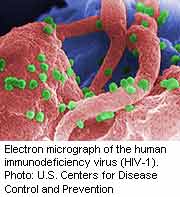
THURSDAY, Aug. 19 (HealthDay News) — HIV-1 in semen is different than HIV-1 in blood, possibly due to changes it undergoes in the genital tract, scientists have found.
In their study, the researchers sought to better understand the process by which HIV — the virus that causes AIDS — is transmitted. They compared the gene encoding the major surface protein of HIV-1 in semen and blood.
The team, from the University of North Carolina at Chapel Hill, the Edward Jenner Institute for Vaccine Research in the United Kingdom and the Baylor Pediatric Center of Excellence (Malawi), published their findings in the Aug. 19 online edition of the journal PLoS Pathogens.
“In some men, the virus population in semen was similar to that in the blood, suggesting that virus was being imported from the blood into the genital tract and not being generated locally in the genital tract,” study author Ronald Swanstrom said in news release from the journal’s publisher.
“However, we found two mechanisms that significantly altered the virus population in the semen, showing that virus can grow in the seminal tract in two different ways,” he added.
One way involves the rapid growth of one or more viruses in the seminal tract over a short period of time, resulting in a relatively similar population of HIV, compared to the complex population in blood. In the other way, HIV replicates in T-cells in the seminal tract over a long period, leading to a separate population of HIV in semen that is both complex and distinct from HIV in the blood, the study authors explained in the news release.
It’s not known if these differences change the biology of HIV or if these changes play an important role in HIV transmission. What is clear is that HIV in the blood doesn’t always represent the HIV at the site of transmission, the scientists reported.
More information
The U.S. National Institute of Allergy and Infectious Diseases has more about HIV/AIDS.

